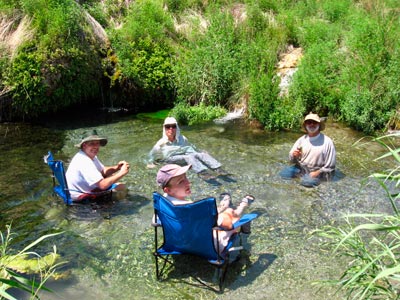

Traveling north towards Cherry Creek, Nevada, along the old shelf road on the west side of Steptoe Valley, ranches can be seen scattered here and there marked by a small stand of trees. Several places have trees but no longer have any buildings. Monte Neva Hot Springs is one of these sites. This fascinating spring is on private land, but we hope to include it in our hydrology field trip with the owner's permission. Image provided by Matt Bowers, Third Media.
We're still working out the details for this trip. Please check back as we get closer to our event dates.
Busses for this trip will depart from the Bristlecone Convention Center on Wednesday morning. Lunch will be provided. No technical gear will be required. The group will return to the convention center in early evening.
Poster sessions and a social networking event are planned at the convention center upon our return.
Nevada's Great Basin is known for its diverse geothermal features, including numerous hot springs that showcase unique geochemical characteristics. The region's hot springs are often associated with tectonic activity related to the extension of the Earth's crust, as the Great Basin is characterized by active faulting and stretching. The geochemistry of these hot springs reflects the complex interactions between subsurface geological processes and the circulation of groundwater.
One notable aspect of hot spring geochemistry in Nevada's Great Basin is the presence of various minerals and elements dissolved in the thermal waters. These hot springs often contain high concentrations of silica, carbonate minerals, and trace elements picked up from the surrounding rocks during the water's journey through the Earth's crust. The specific composition of the hot springs can vary widely from one location to another, providing valuable insights into the geological conditions and rock formations in the region.
Furthermore, the temperature and pH of Nevada's Great Basin hot springs can vary, influencing the types of microbial life that thrive in these environments. Microorganisms adapted to extreme conditions, known as extremophiles, are often found in the hot springs, contributing to the overall ecosystem. The microbial communities play a role in shaping the geochemical signature of the hot springs, as they interact with the dissolved minerals and can influence the precipitation of certain mineral deposits.
Hot spring geochemistry in Nevada's Great Basin is of interest not only for its geological significance but also for potential applications in geothermal energy production. Understanding the composition and behavior of thermal waters in the region is crucial for assessing the feasibility of harnessing geothermal resources for sustainable energy production. Researchers and scientists continue to study the geochemistry of these hot springs to gain a deeper understanding of the Earth's subsurface processes and to unlock the potential for clean and renewable energy sources in the Great Basin.

Lehman Caves is one of the largest and most dazzling cave systems in the Silver State and has been stunning visitors since the 1800s. This immaculate cave system was discovered by Absalom Lehman in the late 1880s after experiencing an uncharacteristically cool breeze coming out of the ground. Image provided by the Nevada Commission on Tourism.
Learn More
There are 48 miles of perennial streams, and over 400 springs in the South Snake Range, home to Great Basin National Park. Over 75% of wildlife species are dependent upon these riparian areas for food, water, and cover at some stage of their life cycles.

Troglodyte Playing Cards
We have no idea what these will look like yet, but we couldn't think of hosting NCKMS in Nevada without offering some themed-out playing cards. There's a good chance the card backs will feature a cave animal of the year, but we still have some time to figure it out.
Advance registration for the 2025 symposium is expected to open in mid-2024. We will send an email to past attendees when that system comes online.
Feel free to join our mailing list if you would like to receive occasional updates on our plans.